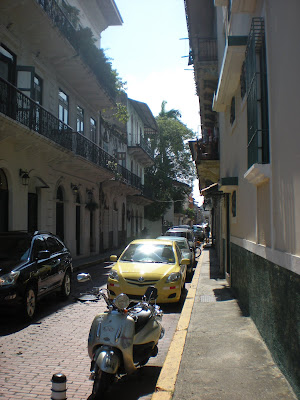Sorry, no pictures yet because this computer has no working USB port (and three non-working ones!)
Ever-popular with foreign tourists and with good reason, Granada is a city where you can take pictures of the beautiful architecture almost without effort. Casco Viejo in Panama City was being restored to its former glory when we were there, but in Granada the process has been completed.
Tourism is clearly a huge moneymaker in Granada, with backpacker hostels and tour companies all over the place, as well as many touts and independent vendors clearly targeting the tourist market. But this is not to say Granada is in any sense not "the real Nicaragua". There are bustling markets catering primarily to locals, and all over the place one sees political banners and graffiti pertaining to next year´s Presidential election.
Granada´s got a reputation as a historic center of right-wing politics (nemesis of lefty Leon) but the political signs and slogans we´ve seen have been overwhelmingly pro-Sandanista. Same in Ometepe, come to think of it; maybe the Sandanistas are just more prone to decorate walls and buildings?
We spent a day and a half exploring the city, taking pictures of its old buildings (which I hope to have on the blog soon). We saw several churches, and heard much on the history of the city, much more about William Walker than the Contras/Sandanistas. Walker was an American warlord (he´s usually called a "filibuster" or "adventurer", but "warlord" sure seems like the best term from our perspective) who tried to conquer all of Central America in the 1850s with Granada as his capital before he burned much of the city to the ground.
The next day was a day trip to Masaya. Lonely Planet describes Masaya as having a touristy handicrafts market which is a good place to shop for local handicrafts, and a local market where all the, well, locals shop. We got off the bus in the pouring rain (Tropical Storm Matthew´s advance scouts) and made for the local market, which turned out to be HUGE, partially covered, and in parts very touristy. We bought umbrellas (at which point the rain abated) and sat down for lunch at a very non-pretentious counter. I was amused that, while we both ordered pollo asado, what we got was chicken cooked in very different ways; she got warm roast chicken, while I got room temperature fried chicken, possibly from the day before.
With the rain stopped, the two of us walked across town to the touristy market. It turned out to be very touristy indeed; the only people we saw who appeared to be locals were working there, and the stalls mostly all sold the same sorts of merchandise, much of it rather generic Nicaraguan souvenirs (including tacky cups shaped like women´s breasts featuring Nicaraguan slogans, which were being sold by vendors across the market). But it wasn´t all bad, and we bought a table runner, and we relaxed for coffee and tres leches in the cafe. (The waiter initially said they didn´t have tres leches; then he reconsidered and said they did. After a wait, we received two servings of tres leches, in cheap plastic cups. We think he ran out to the neighborhood panaderia to procure them for us. They were pretty good, at any rate.)
 Then we went over to check out the baby spider monkey that someone had brought to the cafe. He took quite a liking to Jenna. She wouldn´t have been able to pry him off her neck without his keepers´assistance.
Then we went over to check out the baby spider monkey that someone had brought to the cafe. He took quite a liking to Jenna. She wouldn´t have been able to pry him off her neck without his keepers´assistance.

























